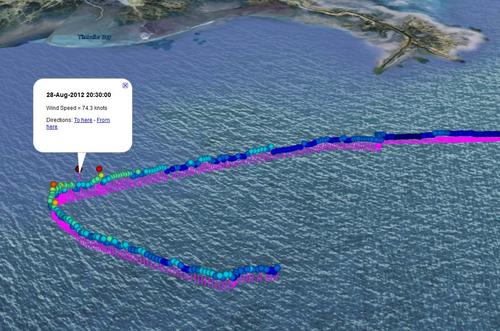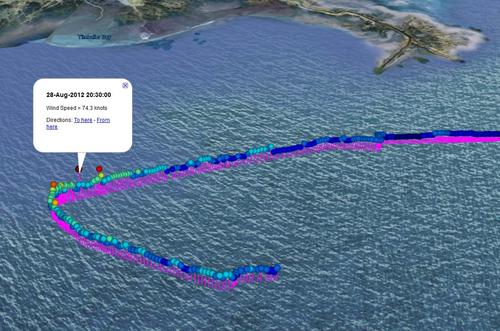September 6, 2012

A robot collecting oceanographic data in the Gulf of Mexico got a close-up look at Hurricane Isaac last week as the eye passed 60 miles east of where the robot was cruising.
A Wave Glider developed by Liquid Robotics and launched by the National Oceanic and Atmospheric Administration (NOAA) was minding its own business collecting ocean chemistry and other data when the storm changed direction and passed over the robot, dubbed G2, according to a Liquid Robotics press release.
The seven-foot Wave Glider is a solar-powered surfboard with a propulsion system and sensors to measure water temperature, wind speeds, barometric pressure, and air temperature. Scientists are starting to use these robots in their exploration of the oceans.

The Wave Glider provided data about what it was like in the Gulf during the storm, which featured sustained wind gusts of up to 74 knots and barometric pressure that fell to 988.3mbar, according to Liquid Robotics. Isaac battered Louisiana and Alabama last week, leaving floods and other damage in its wake.
Bill Vass, the company's CEO, said in the press release that the survival of the robot and its ability to transmit data in the face of severe winds and ocean waves was a testament to its sturdy design and bodes well for the future use of the gliders in hurricane research and prediction. "Hopefully, autonomous platforms like the Wave Glider will make it possible to better predict the severity and risk to everyone in the Gulf Coast area in the future."
As the G2 Wave Glider braved Hurricane Isaac, another Wave Glider, dubbed Alex, was on the other side of the Gulf near Puerto Rico as part of a joint project by the NOAA's Atlantic Oceanographic and Meterological Laboratory (AOML) and Liquid Robotics to study hurricane activity in the region. Alex is using its sensors to measure ocean and air conditions both above and below the surface of the water to help predict when the next hurricane will occur and also when it might increase in intensity, according to Liquid Robotics.
Tracking hurricanes isn't the only use scientists are finding for the Wave Gliders. As we reported last week, they are also exploring the Pacific Ocean near San Francisco as part of a wireless network of sensors and buoys that Stanford University researchers are using to track sharks.
The NOAA says it also has deployed Wave Gliders as part of a network of buoys in the Gulf of Mexico to measure the potential for tsunamis after earthquakes.
Related posts:
About the Author(s)
You May Also Like



